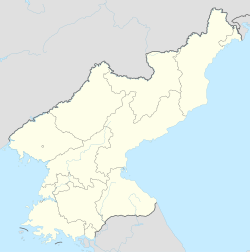Kanggye
|
Kanggye 강계시 |
|
|---|---|
| Municipal City | |
| Korean transcription(s) | |
| • Chosŏn'gŭl | 강계시 |
| • Hancha | 江界市 |
| • McCune-Reischauer | Kanggye-si |
| • Revised Romanization | Ganggye-si |

Factory in Kanggye
|
|
| Coordinates: 40°58′N 126°36′E / 40.967°N 126.600°E | |
| Country |
|
| Region | Kwansŏ |
| Area | |
| • Total | 263.667 km2 (101.802 sq mi) |
| Population (2008) | |
| • Total | 251,971 |
| • Dialect | P'yŏngan |
Kanggye is the provincial capital of Chagang, North Korea and has a population of 251,971. Because of its strategic importance, derived from its topography, it has been of military interest from the time of the Joseon Dynasty (1392-1910).
During the Korean War, after being driven from Pyongyang, Kim Il Sung and his government temporarily moved its capital to Kanggye after first moving temporarily to Sinuiju.
Kanggye is located at the merging point of four rivers, including the Changja River.
Kanggye is divided into 34 tong (neighbourhoods) and 2 ri (villages):
Kanggye is a transportation hub, connected to other cities by road, rail and air. It lies at the junction of the Kanggye and Manp'o Lines. In addition, highways connect it to Pyongyang and other locations. The city is located near a military and civilian dual-purpose air station.
Kanggye University of Education, Kanggye University of Technology, and the Kanggye University of Medicine are located in the city.
Places of tourist interest include Inphung Pavilion and Mount Ryonhwa.
From 1945, the manufacturing industry developed rapidly.
Kanggye has a mining industry producing copper, zinc ore, coal and graphite.
Kanggye hosts one of the main timber processing factories of Chagang province and North Korea.
Kanggye Timber Processing Factory is a small state-run factory located in Kanggye City. At the start of operations, it produced only two kinds of furniture (dining tables and sterilized chopsticks) through manual labour. Over time it has developed into a comprehensive modernized furniture producer, producing woodwork with a hundred and dozens of modern facilities in production.
...
Wikipedia

